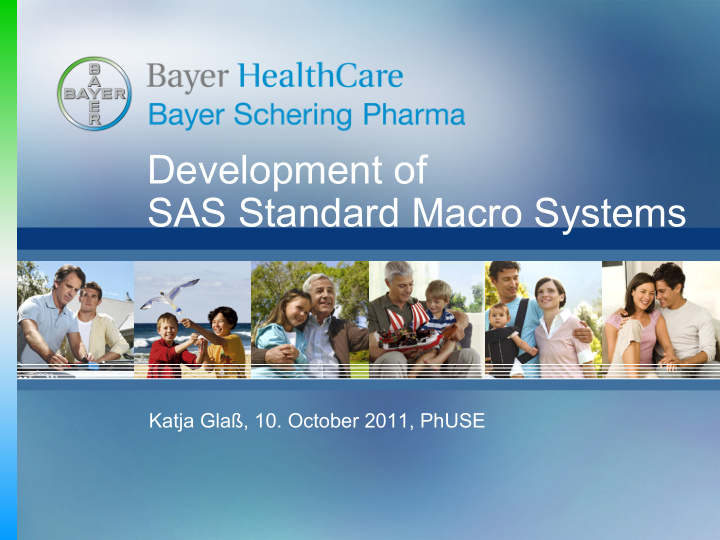



Development of SAS Standard Macro Systems Katja Glaß, 10. October 2011, PhUSE
Contents l Introduction l Macro System Paradigms l Specifications l Implementation and Rollout l Additional Tips l Summary l References Development of SAS Standard Macro Systems – Katja Glaß • 10. October 2011, Phuse • Page # 2
Introduction l Productivity, Quality l Standardized programs / results l Reduced validation effort l ”Source generator” l Commercial software Development of SAS Standard Macro Systems – Katja Glaß • 10. October 2011, Phuse • Page # 3
Macro System Paradigms - Purpose l ”Toolbox“ - bunch of tools l Daily needed supporting tools l “closed“ macro systems l Few parameters with low complexity and flexibility l “open“ macro systems l Many options with high complexity and flexibility Development of SAS Standard Macro Systems – Katja Glaß • 10. October 2011, Phuse • Page # 4
Macro System Paradigms - Types l SAS Macros called in SAS l SAS Macros called by a GUI l SAS Macros called via Web l User groups l Efficiency l System confidence Development of SAS Standard Macro Systems – Katja Glaß • 10. October 2011, Phuse • Page # 5
Macro System Paradigms - Developer l In house development Ressources - Company knowledge, workflow, processes, cases - Motivation, Acceptance l External development - Expertise, efficiency for documentation, implementation and validation - Less user-friendly, enhancement barriers Development of SAS Standard Macro Systems – Katja Glaß • 10. October 2011, Phuse • Page # 6
Macro System Paradigms - Models l Design Models l Waterfall Model (Requirements, Design, Implementation, Verification, Maintenance) l V Model (Concept, Architecture, Detailed Design, Test & Verifications) l Rapid Prototyping l Agile Programming e.g. Extreme Programming (XP) (Frequent Loops) Development of SAS Standard Macro Systems – Katja Glaß • 10. October 2011, Phuse • Page # 7
Macro System Paradigms l Extreme Programming (XP) l Frequent releases l Short development cycles l Changing customer requirements l High user acceptance Figure 1: Extreme Programming l Quick wins Development of SAS Standard Macro Systems – Katja Glaß • 10. October 2011, Phuse • Page # 8
Specifications How the customer How the analyst What the customer explained it designed it really needed Figure 2: Specifications Development of SAS Standard Macro Systems – Katja Glaß • 10. October 2011, Phuse • Page # 9
Specifications l Who is creating specifications (specifications via group) l Technical / content knowledge l Group size l Small à efficient l Large à comprehensive l Types l Enforced ó pleased l Skills l Functions l Empowered Development of SAS Standard Macro Systems – Katja Glaß • 10. October 2011, Phuse • Page # 10
Specifications l How is the specification l Technical, content wise l Detailed, strict, interpretation open l Exception handling Less is more, but not enough! Development of SAS Standard Macro Systems – Katja Glaß • 10. October 2011, Phuse • Page # 11
Implementation • Phases and motivation during implementation 70% 60% 50% 40% 60% 30% 20% 20% 20% 10% 0% Implementation Validation Documentation & Training Development of SAS Standard Macro Systems – Katja Glaß • 10. October 2011, Phuse • Page # 12
Rollout – Background of Users Daily work Training sessions Learning Curve Development of SAS Standard Macro Systems – Katja Glaß • 10. October 2011, Phuse • Page # 13
Rollout – Background of Users • Open for changes • Accept changes • Conservative Accept Changes Conservative Open for Changes Development of SAS Standard Macro Systems – Katja Glaß • 10. October 2011, Phuse • Page # 14
Rollout – Motivation of Users • User-friendly • Support, training, documentation, intuitive parameters • From-Ourselves-For-Ourselves - Implementation / Specification • Embedding in enhancement cycle - Change request lists (easy to address) • Confidence into the system - No black box • “Fun” part • Management support - Enable / force learning time Development of SAS Standard Macro Systems – Katja Glaß • 10. October 2011, Phuse • Page # 15
Additional Tips • Collect any idea - Could result in significant improvements • New ideas by students - Work experiences, bachelor and master theses - Recruitment support • Focus on users Development of SAS Standard Macro Systems – Katja Glaß • 10. October 2011, Phuse • Page # 16
Summary • General principles (SAS macros, GUI, inhouse, … ) • User as developer • Teams as small as possible • Rapid Prototyping for fast benefits • One-Person-Projects • Continues improvements through user ideas • Focus on Users Development of SAS Standard Macro Systems – Katja Glaß • 10. October 2011, Phuse • Page # 17
References • Figure 1: http://en.wikipedia.org/wiki/File:XP-feedback.gif by DonWells 1 May 2001 • Figure 2: http://www.projectcartoon.com/cartoon/2 Share your thoughts on PhUSE Blog!!! Development of SAS Standard Macro Systems – Katja Glaß • 10. October 2011, Phuse • Page # 18
Make your users happy!!!
Recommend
More recommend